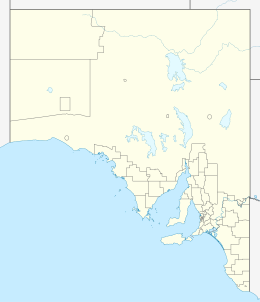Williams Island (South Australia)
| Geography | |
|---|---|
| Location | Great Australian Bight |
| Coordinates | 35°01′50″S 135°58′30″E / 35.03056°S 135.97500°ECoordinates: 35°01′50″S 135°58′30″E / 35.03056°S 135.97500°E |
| Administration | |
|
Australia
|
|
Williams Island is an island in the Australian state of South Australia located off the south coast of Jussieu Peninsula on Eyre Peninsula approximately 34 km (21 mi) south-east of Port Lincoln. It was named by Matthew Flinders for Robert Williams who subsequently lost his life along with seven other crew in the capsize of a cutter launched from the HM Sloop Investigator to search for water on 21 February 1802. Since 2004, the island has been part of the Memory Cove Wilderness Protection Area.
Williams Island which is approximately 34 km (21 mi) south-east of Port Lincoln and 1.8 km (1.1 mi) south-south-east of West Point on the Jussieu Peninsula is broadly a U-shaped island with a maximum height of 40 m (130 ft) and an area of 141 ha (350 acres). While the island is bordered by cliffs, a bay with a sandy beach on its north coast provides both a sheltered anchorage for most wind directions and a point of access to the island.
Williams Island was formed about 9100 years ago when sea levels began to rise at the start of the Holocene.
The island's geological structure consists of an upper platform of calcarenite laying over on ‘a U-shaped ridge of pink granite, dark coloured porphyritic granite gneiss with intrusions by large, dark dolerite dykes.’ The open end of the U aligns with the island's northern coast. The U-shaped ridge is visible as an ‘encircling wall of steep cliffs and talus slopes’ over which the ‘calcarenite platform starts as a talus slope of fractured rock and scree or as low cliffs and overhangs’ thickens into ‘a thick layer of soil’ covering most of the island.
...
Wikipedia

